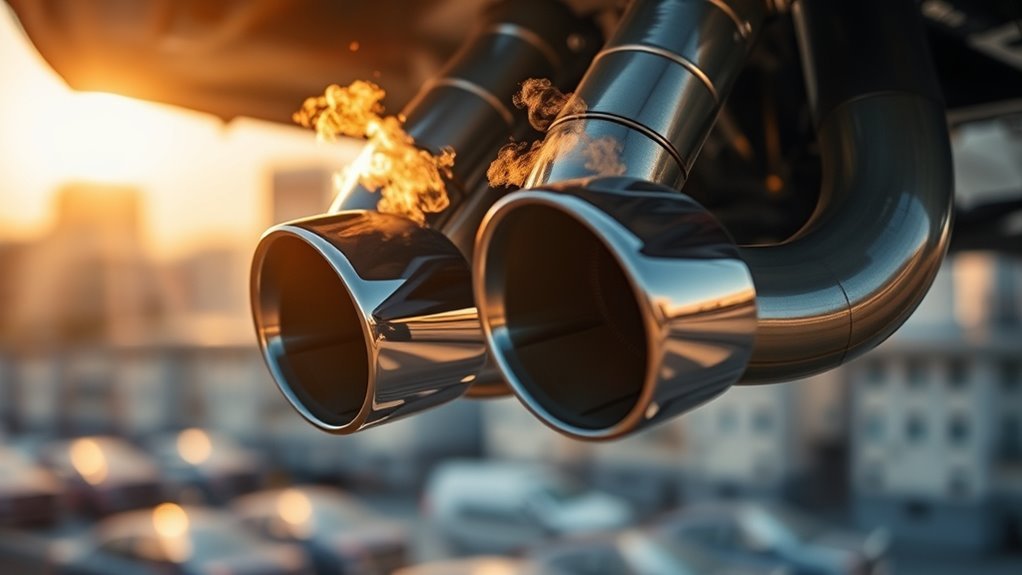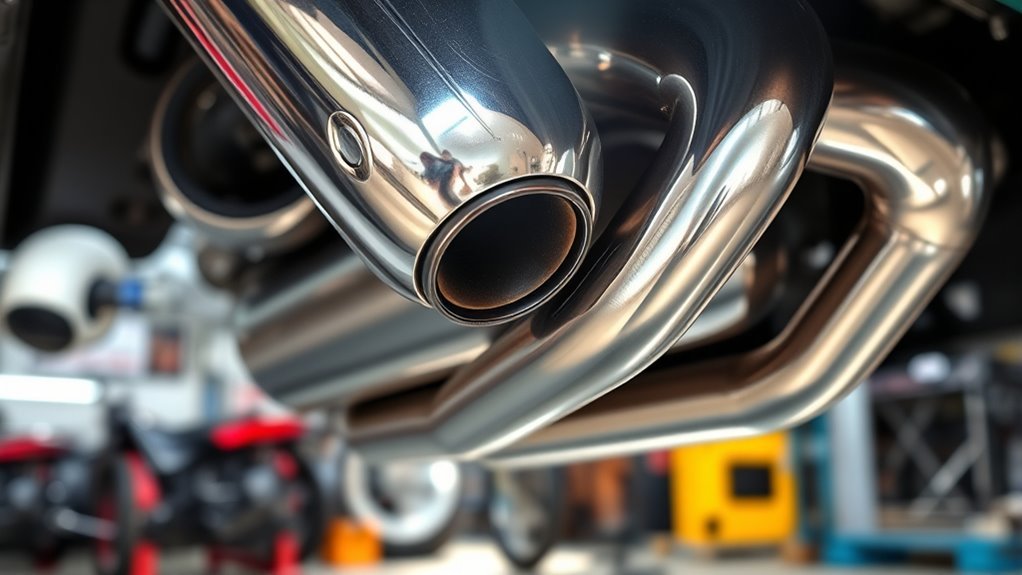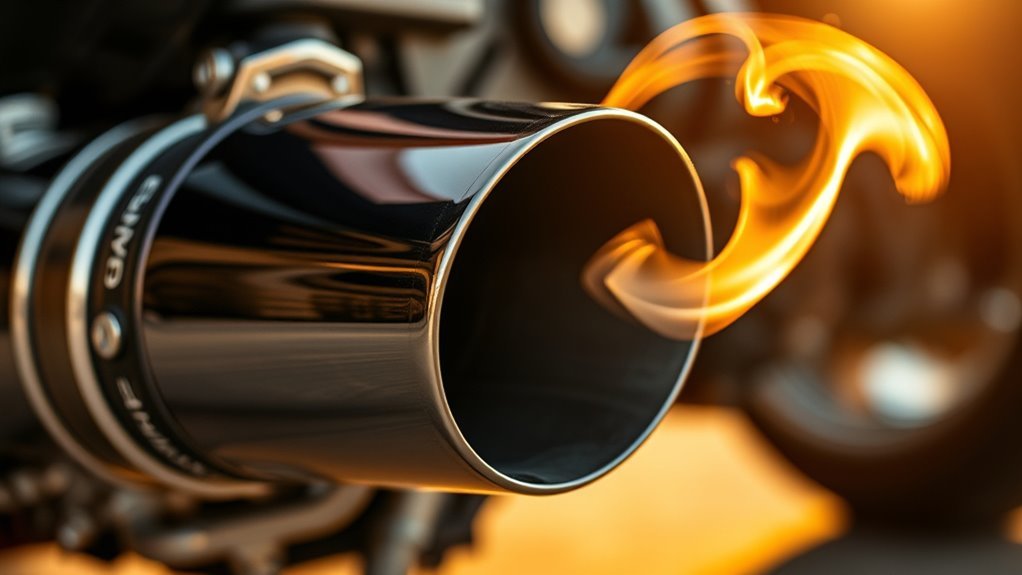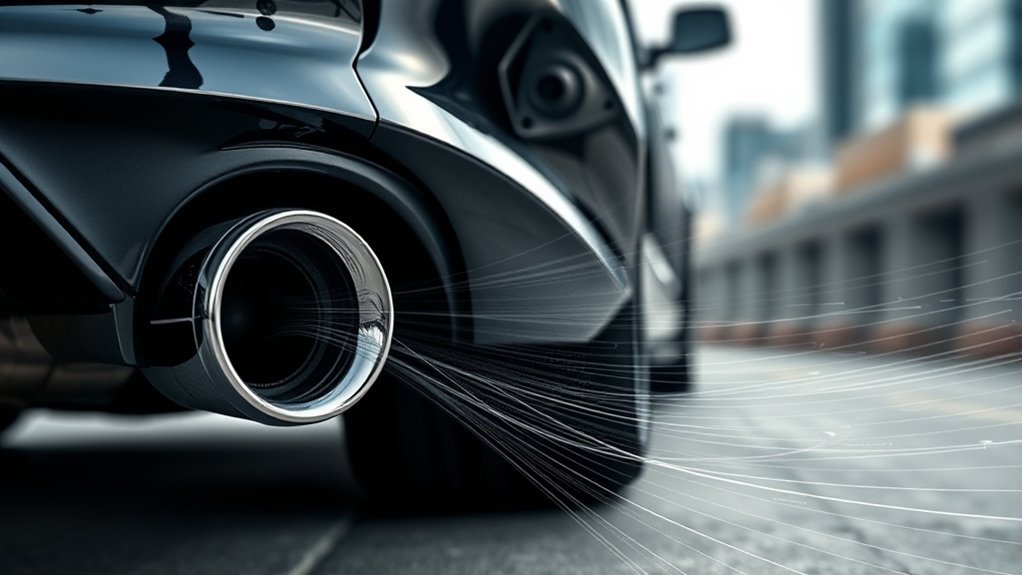Exhaust drone refers to the low-frequency noise created by your vehicle’s exhaust system, often felt as a constant hum or vibration at specific RPM ranges. It typically arises from a mismatch of exhaust components, exhaust piping diameter, or high-performance systems amplifying the sound. This drone can disrupt your driving experience and lead to discomfort. Understanding the nuances of drone can help you mitigate its effects, and there’s more to explore on solutions and upgrades.
Understanding Exhaust Drone: A Definition

Exhaust drone refers to the low-frequency sound produced by an engine’s exhaust system, particularly noticeable at specific RPM ranges. This phenomenon, often characterized by a persistent hum or vibration, results from drone frequency aligning with the engine’s operating harmonics. When certain RPM thresholds are reached, the exhaust system can create drone resonance, amplifying the sound and potentially leading to discomfort within the cabin. Understanding these dynamics is essential for those who value a tailored driving experience. The goal is to minimize intrusive noise while maximizing performance. By addressing exhaust drone, you can enhance your vehicle’s acoustic profile, achieving both freedom and enjoyment on the road without the distraction of unwanted sound interference.
Common Causes of Exhaust Drone

When certain factors align within your vehicle’s exhaust system, drone can become a significant issue. One common cause is the mismatch between the exhaust components, such as headers and mufflers, which can create resonance at specific drone frequencies. Additionally, the diameter of the exhaust piping can affect airflow, leading to unwanted vibrations. If your vehicle has a high-performance exhaust system, it may amplify drone due to increased volume and altered sound characteristics. Furthermore, improper mounting or loose connections can exacerbate the problem, allowing the exhaust to vibrate more freely. Finally, the vehicle’s overall design, including cabin acoustics, plays a role in how drone manifests, influencing how you experience sound inside the vehicle.
How Exhaust Drone Affects Driving Experience

Exhaust drone notably influences your driving experience by altering noise levels within the cabin, which can detract from overall comfort. This constant background noise can lead to fatigue during longer drives and may mask essential engine sounds, affecting your perception of performance. Understanding these factors is vital for optimizing both comfort and vehicle efficiency.
Noise Level Impact
While many enthusiasts appreciate a robust engine sound, the presence of drone in the exhaust system can considerably alter the driving experience. Drone frequency often manifests at specific RPM ranges, resulting in an intrusive noise that can distract from the overall enjoyment of driving. Poor sound absorption materials can exacerbate this issue, leading to a resonant hum that permeates the cabin.
| Impact Level | Noise Description | Driving Experience |
|---|---|---|
| Low | Subtle background noise | Minimal distraction |
| Moderate | Noticeable drone | Can become irritating |
| High | Overwhelming resonance | Detracts from enjoyment |
| Variable | RPM-dependent drone | Fluctuates with speed |
| Tuning | Adjusts drone frequency | Customizable experience |
In essence, understanding drone can help you enhance your freedom on the road.
Comfort During Driving
Although many drivers may not initially recognize it, the level of drone produced by an exhaust system can greatly impact comfort during driving. Excessive cabin noise from drone can lead to fatigue, distracting you from the road and diminishing your overall experience. When the sound becomes intrusive, it compromises driving comfort, making long journeys less enjoyable. A refined exhaust system should minimize unwanted frequencies, allowing for a pleasant cabin environment. You want to feel connected to the road without overwhelming noise levels that drown out essential cues. By selecting systems that balance performance with reduced drone, you can enhance your freedom on the road, ensuring that every drive is as comfortable as possible while still enjoying the thrill of driving.
Engine Performance Influence
A well-tuned exhaust system not only enhances comfort but also plays a significant role in engine performance. When considering performance upgrades, understanding how exhaust drone affects your driving experience is essential. Here’s how it influences your vehicle’s dynamics:
- Power Output: Excessive drone can disrupt ideal exhaust flow, potentially reducing power during acceleration.
- Throttle Response: A misaligned exhaust system may lead to sluggish throttle response, impacting your driving enjoyment and efficiency.
- Fuel Efficiency: Poorly tuned exhaust can worsen fuel economy, negating the benefits of engine tuning.
Identifying the Signs of Exhaust Drone
How can you tell if your vehicle is experiencing exhaust drone? Pay attention to the sound frequency produced by your exhaust system, particularly during acceleration. If you hear a constant, low-frequency hum or vibration, that’s likely a sign of exhaust drone. These resonance effects can create an uncomfortable driving experience, especially at certain RPMs, where the drone frequency intensifies. You might also notice a change in how your vehicle feels; vibrations may resonate through the cabin, affecting comfort. Additionally, if you’re feeling fatigue on long drives, it could stem from persistent drone. Monitoring these auditory and physical signs can help you pinpoint exhaust drone, allowing you to take corrective measures for a more enjoyable ride.
The Impact of Exhaust Drone on Vehicle Performance
Exhaust drone can greatly affect your vehicle’s performance beyond just causing discomfort. This phenomenon can lead to several issues that compromise your driving experience:
Exhaust drone impacts vehicle performance, leading to reduced power, altered sound detection, and increased wear on components.
- Reduced Power Output: Excessive exhaust vibration may disrupt engine efficiency, ultimately leading to power loss.
- Altered Sound Frequency: A persistent drone can mask important sound frequencies, making it hard to detect other mechanical issues, which can affect maintenance and repair.
- Increased Wear and Tear: The constant vibration from drone can accelerate wear on exhaust components and related systems, potentially leading to costly repairs.
Understanding these impacts is essential for maintaining peak vehicle performance. Being aware of how exhaust drone influences your ride can empower you to seek solutions that enhance your driving freedom.
Solutions to Minimize Exhaust Drone
While addressing exhaust drone may seem intimidating, several effective solutions can greatly minimize its impact on your vehicle’s performance. First, consider using sound dampening materials in your exhaust system; these can absorb and dissipate unwanted frequencies, aiding in drone reduction. Additionally, adjusting your exhaust system’s design—such as incorporating resonators or mufflers—can help alter sound waves, effectively reducing drone. If you’re looking for a more straightforward approach, check your mounting points; loose components can amplify drone, so make certain everything is secure. Finally, experimenting with exhaust tips and their orientation can also influence sound output, providing you with the freedom to fine-tune your vehicle’s auditory experience without sacrificing performance.
Upgrading Your Exhaust System to Reduce Drone
Upgrading your exhaust system is a vital step in effectively reducing drone. By understanding the acoustics involved and selecting the right components, you can greatly enhance your vehicle’s sound profile. This discussion will outline effective strategies for optimizing your exhaust system to minimize unwanted noise.
Understanding Exhaust Drone
When you drive, the sound emitted from your vehicle can considerably impact your overall experience, and drone is one of the most common issues that can arise from an inadequate exhaust system. Understanding drone involves recognizing its frequency and how it can affect your comfort. Here are three key aspects to evaluate for effective drone mitigation:
- Exhaust Design: The design of your exhaust system plays a significant role in sound dynamics. A poor design can amplify drone frequencies.
- Material Choices: Different materials can absorb or reflect sound waves differently, impacting drone levels.
- Tuning: Proper tuning can help eliminate unwanted frequencies, enhancing your driving experience.
Effective Upgrading Strategies
To effectively reduce drone in your vehicle’s exhaust system, it’s crucial to contemplate various upgrading strategies that directly address sound dynamics. First, consider exhaust modifications like changing to a high-performance muffler designed for drone reduction. These mufflers often feature internal baffles that mitigate unwanted frequencies, providing a more pleasant sound profile. Additionally, installing resonators can further refine exhaust notes, eliminating specific pitches that contribute to drone. It’s also advantageous to examine your exhaust tubing; opting for larger diameter pipes can enhance flow and reduce backpressure, thereby minimizing drone. Finally, verify proper installation and alignment of components, as misalignment can exacerbate sound issues. By implementing these strategies, you’ll be well on your way to enjoying a drone-free driving experience.
Professional Help: When to Consult a Mechanic
How can you be sure it’s time to consult a mechanic about your vehicle’s exhaust system? If you’re experiencing unusual sounds or vibrations, a professional assessment can help identify the root cause of the drone. Here are three signs indicating you should seek mechanic consultation:
- Increased Noise Levels: If the drone becomes louder, it may indicate a problem with your exhaust components.
- Decreased Performance: A noticeable drop in acceleration or power suggests an exhaust issue that requires expert evaluation.
- Exhaust Fumes: If you smell exhaust inside the cabin, that’s a serious safety concern and warrants immediate attention.
Don’t hesitate to seek professional help; addressing these issues early can save you time and money in the long run.
Maintaining a Comfortable Cabin Environment
While you might not think about it often, maintaining a comfortable cabin environment is essential for both your enjoyment and safety during drives. Effective cabin insulation plays an important role in reducing external noise, which can detract from your driving experience and increase fatigue. Invest in quality materials that enhance soundproofing to achieve the best noise dampening. This not only helps in creating a serene atmosphere but also allows you to focus on the road ahead without distractions. Additionally, verify your vehicle’s climate control system is functioning efficiently to maintain a pleasant temperature. By prioritizing these aspects, you’ll enjoy the freedom of the open road without the nuisance of unwanted noise or discomfort, making every journey a more pleasurable experience.
Frequently Asked Questions
Can Exhaust Drone Damage My Vehicle’s Components?
Yes, exhaust drone can harm your vehicle’s components. The exhaust vibration and specific sound frequency can lead to premature wear on mounts and other parts, potentially causing costly repairs if not addressed promptly.
Does Exhaust Drone Affect Fuel Efficiency?
Exhaust drone doesn’t just annoy; it can dramatically impact your driving experience. Increased fuel consumption often accompanies this phenomenon, leading to less efficiency and ultimately limiting your freedom on the road. You deserve better performance.
Are Certain Car Models More Prone to Exhaust Drone?
Certain car brands with specific engine types often experience more exhaust drone. Performance-oriented models typically amplify exhaust sounds, while others may have design flaws that exacerbate this issue, impacting your driving experience and freedom on the road.
How Does Exhaust Drone Differ From Other Engine Noises?
Did you know that nearly 70% of car enthusiasts report experiencing exhaust drone? Unlike regular engine noises, drone arises from specific exhaust frequencies, often caused by resonance, creating a distinct, sometimes bothersome sound that can impact driving enjoyment.
Will Changing My Muffler Eliminate Exhaust Drone?
Changing your muffler can reduce exhaust drone, but it depends on muffler types and their sound frequency. Selecting a muffler designed to minimize drone can greatly enhance your driving experience and provide the freedom you seek.

